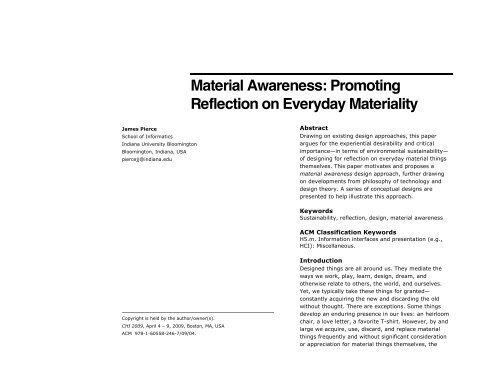Download PDF - James Pierce
Download PDF - James Pierce
Download PDF - James Pierce
Create successful ePaper yourself
Turn your PDF publications into a flip-book with our unique Google optimized e-Paper software.
Material Awareness: PromotingReflection on Everyday Materiality<strong>James</strong> <strong>Pierce</strong>School of InformaticsIndiana University BloomingtonBloomington, Indiana, USApiercejj@indiana.eduAbstractDrawing on existing design approaches, this paperargues for the experiential desirability and criticalimportance—in terms of environmental sustainability—of designing for reflection on everyday material thingsthemselves. This paper motivates and proposes amaterial awareness design approach, further drawingon developments from philosophy of technology anddesign theory. A series of conceptual designs arepresented to help illustrate this approach.KeywordsSustainability, reflection, design, material awarenessACM Classification KeywordsH5.m. Information interfaces and presentation (e.g.,HCI): Miscellaneous.Copyright is held by the author/owner(s).CHI 2009, April 4 – 9, 2009, Boston, MA, USAACM 978-1-60558-246-7/09/04.IntroductionDesigned things are all around us. They mediate theways we work, play, learn, design, dream, andotherwise relate to others, the world, and ourselves.Yet, we typically take these things for granted—constantly acquiring the new and discarding the oldwithout thought. There are exceptions. Some thingsdevelop an enduring presence in our lives: an heirloomchair, a love letter, a favorite T-shirt. However, by andlarge we acquire, use, discard, and replace materialthings frequently and without significant considerationor appreciation for material things themselves, the
Figure 1. The Table that Countsdisplays the total number of heavyobjects that have been placed on itduring its lifetime.hand. Ihde formally represents embodiment relationsas follows:(I-technology) worldHermeneutic relations are human-technology relationswhere the artifact provides a representation of theworld that we may “read” and interpret and,consequently, come to new understandings of theworld. As an example, consider a person’s “reading” ofthe patina that develops on a well-loved piece offurniture, where particular markings refer to particularevents in the person’s experience using the object.Ihde formally represents hermeneutic relations asfollows:I (technology-world)Alterity relations are characterized by “relations toor with technology.” Via alterity relations, technology isexperienced as a quasi-other, something present to usin ways similar to yet not truly human [7]:98. As anexample, consider the relationship an individual has toa well-loved automobile, which the individualconsciously cares for and relates to as a material entity.Ihde formally represents alterity relations as follows:I technology(-world)We may interpret these human-technology relations ofembodiment, hermeneutic, and alterity as respectivelyoccupying spaces along a continuum from readiness-tohandto presence-at-hand. This continuum serves as auseful framework when considering how to approachthe design of everyday objects that occasionallypresent themselves to us in engaging and provocativeways, i.e., designing for material awareness.Technology, and in particular computing technology, istypically designed to perceptually disappear fromconscious experience as we use it. When technologydoes breakdown in Heidegger’s terms and present itselfto us—becoming present-at-hand—this is typicallyconsidered either a failing of the design or a means tosome purely functional end such as customization orrepair. This need not be the case. Instead, we mayconsider intentionally designing breakdowns that leadto experiences with technology that may grow andimprove over time. In what follows, I more concretelyexplore designing for such interactions and experienceswith technology. I present conceptual prototypesemploying two primary strategies, namely (i)amplifying the histories of things and (ii) amplifying theagency of things. The former emphasizes designing forenduring hermeneutic relations, while the latteremphasizes designing for enduring alterity relations.Amplifying the Histories of ThingsHow can digital technology amplify perceptions of theunique histories of particular objects—and ourexperiential histories with them—over time,encouraging attachment to these objects? How can athing reveal to us over time, via hermeneutic relations,meaningful representations, prompting varying degreesof reflection on the presence of a thing in our life?Consider a series of domestic products augmented withsmall numerical displays—or counters—and varioussensors that record and display simple histories of use.The Table that Counts (Figure 1) has a counterembedded in its face displaying the total number oftimes a heavy object has been placed on the tableduring its lifetime. Dropping an object on the table orotherwise causing shock to its surface causes the
Figure 2. The Lamp that Countsdisplays the total number of years,days, hours, minutes, seconds andmilliseconds the lamp has been litduring its lifetime (milliseconds notshown in this prototype).counter to become erratic, gradually returning to itscorrect count. The numbers on the counter begin togradually dim if no new objects are placed on the table;eventually, the numbers fade out completely. Placing anew object on the table restores the numbers to thenormal brightness level. The Lamp that Counts (Figure2) has a counter embedded in the lampshadedisplaying the total number of years, days, hours,minutes, seconds, and milliseconds the lamp has beenlit during its lifetime. Turning the lamp on starts thetimer; turning off the lamp stops the timer.The simple and direct communication of mundane usehistoriesis intended to invite reflection on therelationship between short- and long-term experienceswith the objects. These Objects that Count invite anindividual to reflect on her or his history of experienceand existence with everyday useful things—thingstypically designed and used purely as means towardsfunctional ends. Amplifying the histories of thingsinvolves designing emergent and evolvingrepresentations that reflect aspects of a person’sexperience with a particular thing, in turn, altering theway a person engages with and experiences that thing.This material-hermeneutic cycle, prompted by thephysically evolving representation, may encouragemeaningful human-artifact relationships that developand endure with time.reflection on the presence of a thing in our life?Consider a series of domestic products that have beenredesigned to (mis)use their functionality to help themexpress their needs and desires. The Animate Lamptires and begins to dim its light bulb after it has beenleft on for a while. Jostling its shade causes it to startleand brighten. Gently rocking the lamp's shade comfortsthe lamp and causes lights woven within the shadeitself to glow in aesthetic patterns. After a while, thelampshade lights gradually begin to dim unless theshade is again gently rocked. The Animate Clock(Figure 3) occasionally grows bored with showing thecorrect time and deviates by displaying an incorrecttime. This deviation typically lasts only briefly and theclock returns to the correct time, briefly flashing amessage—"HA HA"—to indicate it was only joking.These Animate Objects invite use of their functionalityby means tangential to their core functionality andinhibit use of their functionality by subverting their corefunctionality. In doing so, individuals are invited tointerpret and reflect on these objects as possessinghuman-like needs and desires rather than treatingthem as purely functional. Amplifying the agency ofthings involves designing everyday products to presentthemselves as a quasi-other—an ‘other’ that may berelated to on a deeper experiential and material levelthan is typical of mundane functional products.Amplifying the Agency of ThingsHow can everyday things amplify our perceptions ofthem as possessing agency—possibly even human-likethoughts or behaviors—in order to increase ourattachment to these things? How can a thing reveal tous over time, via alterity relations, meaningfulpresentations of itself, prompting varying degrees ofDiscussion of ‘Prototypes’ and Future WorkThe conceptual prototypes presented here are unlikelycandidates for commercially viable products that anaverage person may readily adopt and integrate intoher or his life—although it is not difficult to imaginevariations of these designs that do meet such criteria.The role of these prototypes is different and twofold.
Figure 3. The Animate Clockoccasionally grows bored withdisplaying the correct time anddeviates by displaying anincorrect time.First, the prototypes serve as concrete embodiments ofabstract theoretical concepts and speculativestrategies, and they provide a more tangible basis forongoing discussion. Second, these prototypes mayserve as probes that can elicit thoughtful responsesfrom users, which may inform and inspire futuredesign. In the future, I intend to use these types ofprototypes in this way to empirically investigate thepotential for material awareness in everyday life.ConclusionIn this paper I have proposed a material awarenessapproach to design, which emphasizes designingeveryday products to occasionally draw attention tothemselves, encouraging us to consider them morethoughtfully. Drawing from philosophy of technologyand design theory, I have presented design strategiesand concepts suggesting directions for futureinteraction design and HCI research aimed atpromoting more enduring and sustainable relationshipswith technology. A goal of this work is to proposeconceptual tools for generating and evaluating designsthat may ultimately facilitate more meaningful andsustainable ways of being in our world with the thingswe create.References[1] Backlund, S., Gustafsson, A., Gyllenswärd, M.,Ilstedt-Hjelm, S., Mazé, R. & Redström, J. (2006).Static! The Aesthetics of Energy in Everyday Things. InProc. Design Research Society WondergroundInternational Conference 2006.[2] Blevis, E. & Stolterman, E. (2007). Ensoulment andSustainable Interaction Design. In Proc. IASDR 2007.[3] Dourish, P. Where the Action Is. (2001). MIT Press.[4] Dunne, A., & Raby, F. (2001). Design Noir: TheSecret Life of Electronic Objects. Birkhäuser.[5] Gaver, W. W., Bowers, J., Boucher, A., Gellerson,H., Pennington, S., Schmidt, A., Steed, A., Villars, N., &Walker, B. (2004). The Drift Table: Designing for LudicEngagement. In Ext. Abs. of CHI '04. 885-900.[6] Huang, E. M. & Truong, K. N. (2008). Breaking theDisposable Technology Paradigm: Opportunities forSustainable Interaction Design for Mobile Phones. InProc. CHI '08, ACM Press, 323-332.[7] Ihde, D. Technology and the Lifeworld - FromGarden to Earth. Indiana University Press.[8] Lefebvre, H. (1987.) The Everyday andEverydayness. In Yale French Studies, 73(10), 7–11.[9] Mazé, R. & Redström, J. (2005). Form and theComputational Object. In Digital Creativity, 16(1), 7-18[10] Nelson, H. & Stolterman, E. (2003). The DesignWay: Intentional Change in an Unpredictable World.Englewood Cliffs, NJ: Educational TechnologyPublications.[11] Odom, W., <strong>Pierce</strong>, J., Stolterman, E., & Blevis, E.(2009). Understanding Why We Preserve Some Thingsand Discard Others in the Context of InteractionDesign. In Proc. CHI '09, ACM Press.[12] Sengers, P., Boehner, K., David, S., & Kaye, J.(2005). Reflective Design. In Proc. of CriticalComputing '05, ACM Press, 49-58.[13] Verbeek, P-P. (2005). What Things Do –Philosophical Reflections on Technology, Agency, andDesign. The Pennsylvania State Press.[14] Winograd, T. & Flores, F. (1986). UnderstandingComputers and Cognition. Ablex Publishing Corp.




